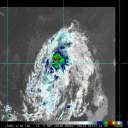Show Selection:
|
#873220 (Received by flhurricane at: 10:56 PM 28.Aug.2016)
TCDAT4
TROPICAL DEPRESSION NINE DISCUSSION NUMBER 2
NWS NATIONAL HURRICANE CENTER MIAMI FL AL092016
1100 PM EDT SUN AUG 28 2016
Flight-level wind data from an earlier NOAA reconnaissance mission
along with WSR-88D Doppler radar data from Key West indicate that
the depression had been moving southwestward between 1800-0000 UTC.
However, the most recent radar data and nearby surface observations
suggest that the cyclone has now turned toward the west. The last
reliable wind data from the NOAA WP-3 recon aircraft supported an
intensity of 30 kt, and that intensity is being maintained for this
advisory given that the radar and satellite signatures haven't
improved. The central pressure of 1007 mb is based on a reliable
observation from ship WMKN, located just north of the center.
The initial motion estimate is 270/08 kt. Now that deep convection
has waned, the system has turned westward and this motion is
expected to continue for the next 24 hours or so. This short term
motion is supported by NOAA recon dropsonde data on the return leg
home, which indicated that 500 mb heights were 10-20 meters higher
over the southeastern Gulf of Mexico than what the global models
have been forecasting. After that time, the global and regional
models are in surprisingly good agreement on the cyclone slowing
down and turning toward the west-northwest and then northward in the
36- to 48-hour periods as the depression moves around the western
periphery of a narrow subtropical ridge that is expected to be
located over the Bahamas and South Florida at that time. By 72 hours
and beyond, the tropical cyclone is forecast to lift out and
accelerate to the northeast as a shortwave trough over the western
Great Lakes digs southeastward and captures the depression. The new
NHC forecast track has been shifted to the right of the previous
advisory track mainly due to the more southerly initial position,
and lies a little to the left of the consensus model TVCN.
Strong vertical shear that has been plaguing this system for the
past week is expected to gradually subside to less than 10 kt in
18-24 hours, which should allow for more organized deep convection
to develop. However, the southerly low-level inflow will still be
disrupted by the terrain of western Cuba until the cyclone moves
west of 85W longitude, which will then provide a straight trajectory
across the Yucatan Channel and into the low-level center. By 36
hours and beyond, the depression will moving over SSTs greater
than 30C and the light vertical wind shear is expected to back
around from a northerly to a southwesterly direction, which usually
favors more significant intensification. However, dry air in the
mid-/upper-levels noted in the recent 0000 UTC soundings from Key
West northward to the Gulf coast is expected be entrained into the
northwestern semicircle of the cyclone's circulation by 48 hours
and beyond, and this appears to be the main inhibiting factor to
strengthening by the global models. Given these mixed signals, the
NHC intensity forecast remains conservative and closely follows the
intensity model IVCN. The confidence in the intensity forecast
remains lower than usual for this system.
FORECAST POSITIONS AND MAX WINDS
INIT 29/0300Z 23.4N 82.7W 30 KT 35 MPH
12H 29/1200Z 23.5N 84.0W 30 KT 35 MPH
24H 30/0000Z 23.8N 85.4W 35 KT 40 MPH
36H 30/1200Z 24.4N 86.8W 35 KT 40 MPH
48H 31/0000Z 25.1N 87.1W 40 KT 45 MPH
72H 01/0000Z 27.0N 86.3W 45 KT 50 MPH
96H 02/0000Z 29.1N 82.9W 50 KT 60 MPH
120H 03/0000Z 31.2N 78.3W 50 KT 60 MPH
$$
Forecaster Stewart |



